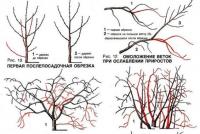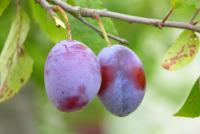Winter-resistant climbing roses without shelter. Review of the best varieties of roses for the Moscow region. How and when to prepare roses for winter
Shelter of roses for the winter - warming "the queen of flowers"
When buying a rose bush in the spring in the nursery or on the market, often a novice grower does not even think about the most important period in the life of the “queen of flowers” - wintering. And after all, it depends on this whether the plant will survive during the harsh cold weather, whether it will successfully continue to grow and rejoice in its rapid flowering. If you are still quite inexperienced florist, then you will be interested to learn how to save roses in winter. About this we now will tell.
We do not know what the coming winter will be like, we only know that it is coming. To be safe, it is recommended to take precautions until the icy winter. Winter protection begins, however, in the summer! Give your beauties last fertilizer after the first flowering, especially after the beginning to mid-July, you no longer need to enter a dose of nitrogen. The shoots do not ripen and are therefore too juicy and therefore too soft in winter rest. Severe frost causes succulent cells to freeze and burst.
In the case of your historic roses, which were planted several years ago, accumulation or other winter protection is no longer needed, the correct planting depth is required. Even grounding do not usually need winter protection. But all the other Modern Roses should at least be folded. Your roses give their protection from frost in the longer sunshine, drift prematurely, and the shoots freeze. Therefore, it is important to shade your pets either spruce or fleece. High stamens are especially at risk, because their frost-sensitive cleaning area is not protected by earth, but is located directly under the crown.
A few words about winter hardiness of roses
Winter hardiness of the rose, that is, its ability to tolerate cold and sudden temperature changes, depends on its type. It is worth purchasing only garden roses intended for cultivation in open ground. Unfortunately, sometimes we have to face a frank deception, when the market, instead of garden roses offer greenhouse options. They do not differ in winter hardiness and will surely die even with careful shelter. Worst of all, in appearance, greenhouse flowers are no different from garden ones. The only correct solution in this situation is to buy seedlings in nurseries or from a trusted supplier.
We continue to wrap the protruding end on the barrel. This fabric retains heat, can not absorb moisture and therefore dries quickly. As a result, rot cannot develop with this protection. Then we link longer or uncontrolled shoots together. Above this is a fleece hood, even better from large bivalve waste papers. Paper cups can be peeled off at any time during periods of the frost-free period and applied quickly without damaging the shoots. For very prickly or thin shoots, we do not recommend jute hoods, because the material is sucked into the water or becomes difficult due to snow load, which means that the shoots are heavily loaded and can break.
As for garden roses, among the variety of varieties also stand out more or less winter-hardy. Most large producers in their catalogs mark this property and divide varieties according to the degree of their unpretentiousness. The most winter-hardy are park or landscape roses, which tolerate cold much better than other varieties.
In this case, tie the stem under the hood to the trunk, which extends beyond the crown, and then reduces the pressure on the shoots. When removing the hood in spring, thorny shoots can also get into the jute fabric, and the loss of young shoots can occur. You can decorate paper caps with flowers, then they look good.
By the way, historic roses on Hochstam do not need winter protection. However, during our late night frosts, we turned over our verified documents. Some rose lovers swear by turning the chests above the cones, and now it becomes more frequent if there is enough space in the bed. Now the whole crown is covered with earth and, possibly, "decorated" with a Christmas tree.
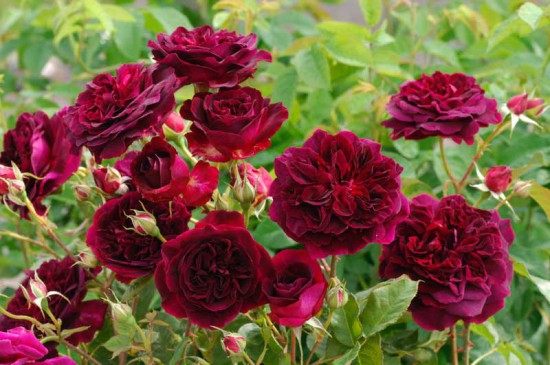
Size and size of plants. Stunted species (ground cover, miniature) cover for the winter is much easier than tall (climbing, erect, unfolded), reaching a height of 1.2 - 1.5 m.
How to prepare roses for winter in summer?
The safety of roses during the winter cold depends not only on high-quality shelter and insulation. It so happens that a bush sheltered according to all the rules still dies. This is because, in the summer, all the arrangements for preparing roses for winter were not carried out. To think about wintering roses should be already at their planting. Place the bushes so that in the future they were easier to cover.
Please do not try this procedure with old samples - the risk of breaking the trunk is great. Restoring roses, which are often subject to strong winds or winds, must also be protected. Again, caution is better than total loss. Eyes protected underground are repressed again, even when all shoots are frozen. As an additional protective measure, fir can be inserted between the shoots in the form of tiles and, possibly, fixed.
Of course, the lifting rose can also be covered with fleece. Please note: most roses do not freeze during a constantly icy period, but because of the relatively strong winter sun. During the day, the rose leaves your winter protection, and the sap rises again in the shoots. In subsequent freezing periods, the juice freezes in the shoots, and when the sun shines on it in the morning, the cells break down due to defrosting too quickly. That is why it is so important that the roses are shaded during the night frosts, as this prevents both premature shoots and also if shoots have already formed, which leads to rapid thawing.
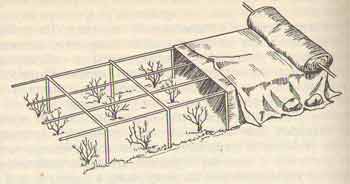
It is best to plant plants in rows. It is necessary to keep a distance of 30–40 cm between the floribunda group, park and hybrid tea, and 20–30 cm of free space between the ground cover and miniature varieties. Dropping off climbing roses, consider in advance how you will insulate the stems.
Roses are best placed on the bed, so they are properly planted. There are also roses that are good for growing baths and that also grow well on balconies. Not all roses are suitable for this. therefore right choice The varieties are especially important. In bed, roses are usually suppressed without problems. It's not easy in the bucket. All roses winter in the open. Rooms do not offer good conditions for arriving in the cold season. Even in the basement they are not in good hands.
Especially highly grown roses are endangered in central Europe in the winter. They are usually bred for appearance and less for favorable properties. Therefore, the choice of varieties is important. Noble bedding and climbing roses are protected from the sun. Although the wood of shoots is frosty, it sensitively reacts to temperature fluctuations. The worst of all is warmer day and night frost. Therefore, it is good to cover the branches with brushwood. If you climb the trellis, you can also take linen or jute bags. Upper stockings have an end point on top, just below the crown. Thus, you pack the twigs around the place and on the branches, and then put a cloth or jute bag on the entire crown. Never use plastic bags, including condensation. It can freeze and cause great damage. This is also the reason that you should pay attention to suitable varieties! The soil potted roses should not freeze, otherwise the water transport is stalled, thirst for roses. That's why you pack your buckets well, with droplets, coconut mats or jute. Do not forget to pour enough water during periods of frost-free period! However, excessive filling and rainwater should be well drained. Ideally place the landing bucket on your feet or on some foam plates. 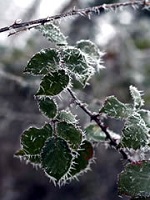
There is too much, and the cold wind is not favorable. Also the balconies should be packaged warmly. They look like bath handles. If the root cannot be properly distributed, hibernation becomes difficult. Tip 4 Simple nutrients will be discontinued in July.
- Before the winter break, the processing area of the rose is especially sensitive.
- One pours a height of 25 cm of garden soil.
- Leaves and sprouts disappear, they only weaken.
- Otherwise, it is better to cut the plants only in the spring.
- Not every rose is suitable for storing buckets.
- The bucket requires a very secure place, preferably in the corner.
- Roses on the balcony are mostly stored in a bucket or in the balconies.
- Again, buckets must be protected.
- Since balconies are usually covered with a roof, water is especially important.
- Plants can not provide for themselves.
- Balcony boxes with dwarf-sized eggs should not remain on the parapet.
- Tip 1 Vessel size is important for potatoes.
- This can be seen only in the spring.
- This allows the branches to ripen well, so that they are not sensitive to frost.
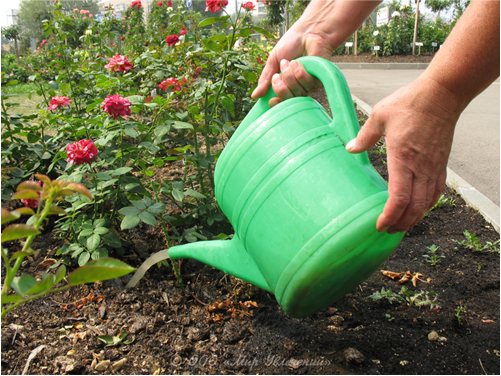
Poor specimens survive badly in winter; therefore, special attention in the summer period should be paid to proper feeding and protection against diseases and insects. Experienced Gardeners It is recommended not to wait for the onset of the disease, but periodically to carry out preventive treatment. Healthy leaves, not spoiled by diseases, contribute to the maximum accumulation of useful substances that will be useful to the plant in winter. With regard to fertilizing, at the end of the summer you need to stop making nitrogen fertilizers that cause plant growth. During this period, you should switch to potash-phosphate compounds, accelerating the aging of shoots. Later flowering of roses can also lead to their depletion. In this case, you need to bend all the buds, not breaking them off, to slow down the growth of the shoots and not allow the lateral buds to wake up.
They fascinate with their flowers and fragrance. Wintering is not very difficult. It's a little more complicated, but it's not bad. It is important to choose correct varieties, the correct location and ideal growth conditions. Rose, one of the most devout plants in our gardens. The rose not only impresses with its variety of colors and shapes, but also fascinates us with its fragrance. Therefore, for every plant lover, of course, it is important to bring your own roses in the cold winter. Proper care for suppressing their roses is true for all species, whether perennial plants, stem roses, wild roses or potted roses.
Preparing roses for shelter
Before the first frosts appear, it is necessary to remove, if not all, then most of the leaves from the rose bush. Especially carefully should thin out them in the lower part of the plant. From climbing roses, the leaves also break off in several approaches, moving from the bottom of the bush to the top. Such a measure will stop the evaporation of moisture from the leaves, as the roots of the plant will slow down their work in the cold earth and will not be able to fill the shortcomings of the liquid. In addition, green leaves can begin to rot under cover, which will lead to the death of the entire plant. Similar troubles are also caused by undisturbed shoots - they are also ruthlessly cut off.
Roses suppress: But right!
This is important so that the buds do not freeze in winter, and the rose can also develop its full magnificence and gorgeous fragrance next spring and summer. Here you can find little tips on winter roses. Pink winter should start with a rose. It is important that this happens before the first frost and immediately after the last flowering. However, a reduction in pink plant production should not occur in the fall. This should happen in the spring, before the first flowering.
The best winter protection for wintering the trunk - the land. The best is the accumulation of 10 to 20 cm of loose soil. However, compost should not be used. To better protect the roots from frost, the soil can be covered with fallen leaves, moss or straw. In the case of the higher pink sticks, there are branches of branches, which are carefully fixed around the rose. Coconut is also suitable for wintering roses.
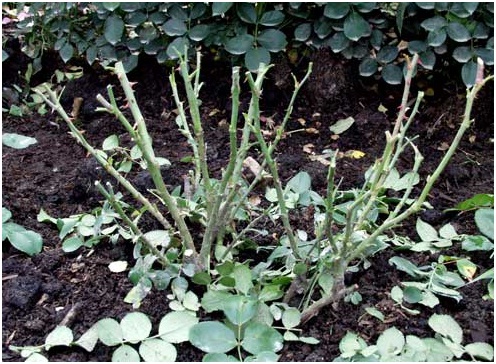
Before covering roses for the winter, many gardeners prefer to cut the plants. The stalks of spray roses are cut to the height of the shelter, while the remaining stems should not be less than 15-25 cm. Such a reserve is necessary so that the grafting sites remain intact. Radically cut roses is not necessary. There is a method in which the stems are simply bent to the ground and fixed in an inclined position with the help of metal studs. Such a solution will allow your roses to bloom 2-4 weeks earlier than their cropped brethren.
In the fall of this year should not be fertilized. Fertilizers will lead to the fact that roses will grow small young shoots. However, they will freeze again in case of frost. As a result, the thirst for roses in spring and summer may worsen. Pink roses can be easily winterized in a bucket. However, the pot must be moved to a protected and heated room. AT open form Roses should only winter if they are optimally protected from frost. It is best to wrap the rose in a jute bag and place the pot in an extra bucket.
How to prepare roses for winter in summer?
The gap should be filled with fleece from the construction market in order to provide adequate protection in the winter. Thus, the "mission" of roses will overflow the winter even in a bucket! When the days get shorter, the resting phase begins for the plants. Then the pots need special attention. Some balcony flowers and delicate plants should be taken to winter quarters before the first night frost. More resistant plants remain outside until the temperature drops well below zero degrees.
Despite all the precautions, winter temperatures, poor ventilation and excessive humidity can lead to rose disease. That is why an anti-fungal treatment of a plant with a solution of ferrous or copper sulfate (at a concentration of 5%) should be carried out before the shelter. It is necessary to spray not only the whole bush, but also the ground under it - there may also be hiding disputes of harmful fungi.
Protect from cold winter pot plants
Protect solid winter plants in buckets
Even the hardy plants that winter in a bucket, such as ornamental grasses, beech trees, hydrangeas or roses, need protection, because otherwise they will freeze in a pot. Pots can be protected in an ecological way with frosted mats, leaves or green fir. Wood or polystyrene under the pots prevents freezing of the root ball. It is important that the plants do not stand in the sun. The variation between very low temperatures at night and higher during the day in the sun damages the plants.Ways of winter shelter of spray roses
The simplest shelter of roses for the winter consists in hilling the bottom of the pruned bush with loose earth or mulch. In this case, a mound of 25–50 cm in height is formed. For better warming, you can fall asleep dry fallen leaves or spruce fir leaves.
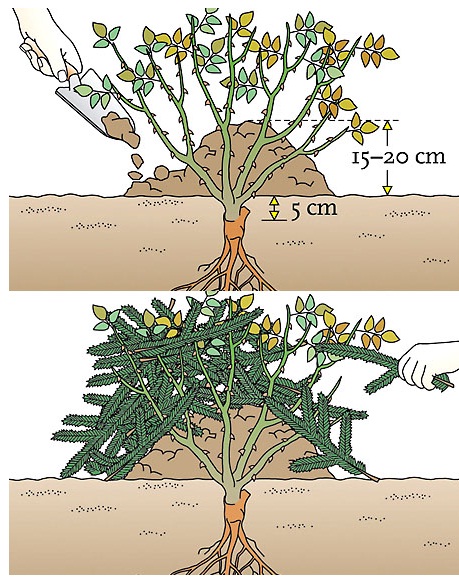
A more efficient way, which allows you to warm the most valuable bushes very qualitatively, is called air-dry. In this case, the rose is either cut, or the stems are pinned to the ground with metal hooks. After this, care for roses for the winter requires sleeping the stems with needles or shelter with fir branches. In the next step, pegs are stuck into the ground, which will serve as the basis for the roof of sheet metal or wooden shield. From above, the whole structure is covered with a thick film, the edges of which are fixed with stones or bricks.
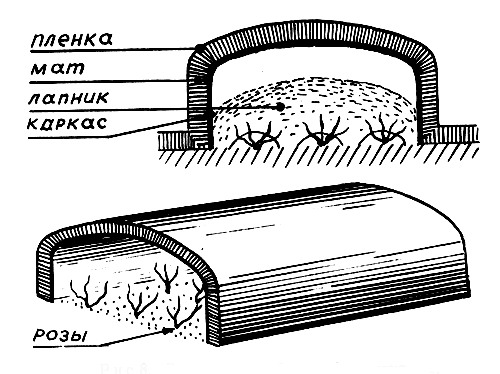
When creating such a shelter, often one edge of the film is left raised. However, this approach can easily force all the warm air inside the shelter and freeze the plant. It is better to bring the ventilation in the form of a thin tube passing along the ground from the inside of the shelter to the outside.
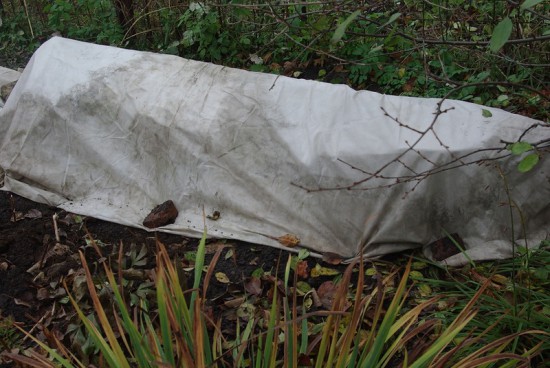
There is a rather well-known variation among gardeners of a similar method, in which a “tent” of planks or bars is arranged around a rounded bush. After covering the structure with a thick film, it becomes completely impenetrable to wind and precipitation. In the middle, the soil will always be dry, and the shoots will be fully preserved until spring.

Shelter of standard roses
Standard roses for the winter do not radically cut, but simply produce sanitary haircuts, taking into account the plant's belonging to a particular variety. In that case, if the bole is young, then it will be easy to bend its stem to the ground and fix it with a pin. The lower part of the plant spouts sand, spruce needles or leaves. Under the crown and the top is placed fir spruce branches or river sand. On top of the whole structure is covered with a film or other waterproofing non-woven material.
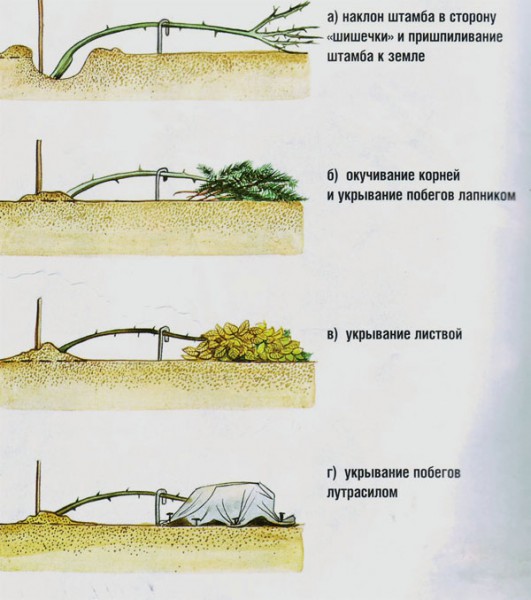
This method is good for everyone, but not suitable for old boles with lignified logs. Don't even try to bend it, chances are great. That is why such specimens are prepared for winter in an upright position or are completely laid on the ground. How to cover the roses for the winter in an upright position? It is very simple: around the trunk there is a metal mesh frame or it is wrapped with roofing felt, leaving free space in the middle.
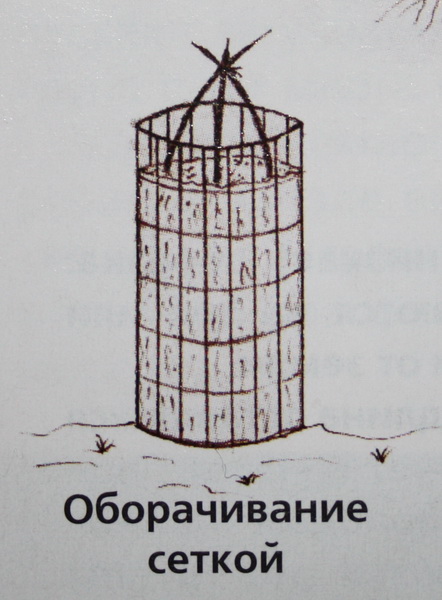
This space is filled with dry leaves, sawdust, spruce needles. A plastic bag is put on top of the construction and tied with a string for fixing. You can also stack the boom entirely on the ground using the Minnesota method. At the same time, they dig a part of the ground near the base of the rose on the side in which it is supposed to tilt it. Then one person takes the trunk from the base and pulls it towards himself in the chosen direction. At the same time, the second person is on the opposite side and launches a shovel into the ground, pressing on that part of the plant where there are two thirds of the root. At the same time, one side of the root system turns up and rises from the ground. The main part of the roots remains intact, although some roots still break. But it's not scary, because root system remains fully viable, and the plant is guaranteed to endure a harsh winter. In the spring, after the root returns to the ground, the damaged surface will quickly acquire new roots.
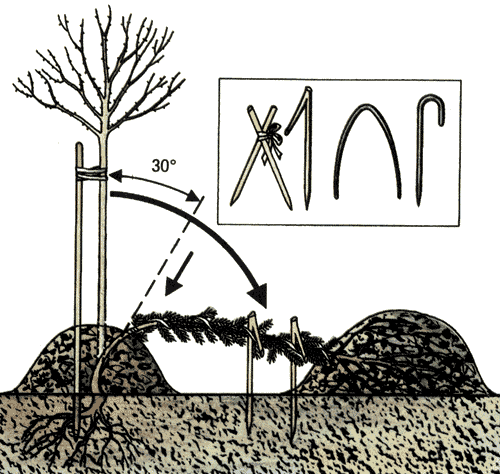
After the trunk is laid on the ground, it is fastened with pins. Raised root, trunk and crown fall asleep with needles, sand, or covered with spruce leaves. It is also advisable to cover the heaped rose with a thick film.
Shelter climbing roses for the winter
Shelter for the winter climbing roses requires special care and caution because of the long lashes of the plant, which is undesirable to damage. The base of the bush, as in all other variants of the shelter, is curled with earth, spruce needles or sand and is covered with spruce branches. The stems are carefully removed from the supports and laid on the pre-laid spruce fir twigs. From above the whip is also warmed with spruce branches and covered with a film.
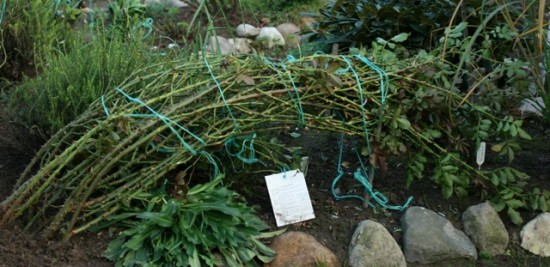
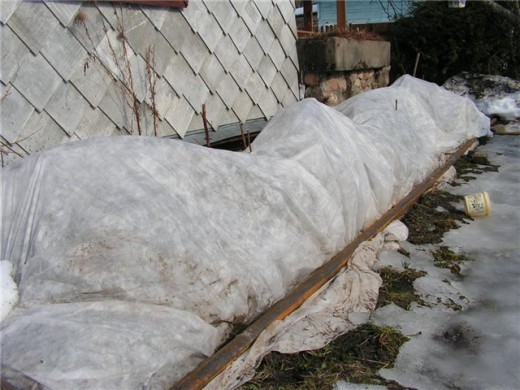
Covering roses for the winter, if they encircle the pergolas, arches or arbors, does not provide for laying the lashes on the ground. The shoots of roses are warmed in this case right on the supports, wrapping them with spruce or sacking. After this covering material is fixed with ropes.

Spring shelter removal
Now you should understand how to save roses for the winter. However, no less crucial moment than warming is the removal of the shelter in the spring. Even the roses that survived the winter may die in the spring, if the shelter is not removed correctly or not in time. When constant positive temperatures are established, the shelter begins to be gradually removed. First, remove the film, then lapnik, pine needles or sand and free the bushes. The best time for these works it is considered to be a windless, not sunny day or evening. One should strive to avoid plant drying and sunburn. For a long time the rose was without light in a humid environment, therefore it should be taught gradually to the changed conditions. All diseased, frostbitten, dry and broken parts are removed from the open plants. In order to prevent roses sprayed with a solution bordeaux fluid at a concentration of 1%.

Following all the above rules, be sure: all yours, even the most valuable varieties, will surely survive the winter and in the spring will delight you with early and abundant flowering.
I hide my roses like this ... In the middle of October or at the end I add roses under the neck near a bucket of earth .. When it is cold in the daytime minus 4. and at night minus 7. I cover roses with lutrasil. Sometimes each one is separate. If planted in one flower bed. they can be tilted and covered with one piece of material .. I throw a piece of film over the cove ... but it’s only on top and is blown from all sides .. I don’t make much of a rose in the fall. I leave everything in the spring .. Sometimes only huge shoots. Lyudmila.
Uncovered roses - a term not often found in our horticultural literature. They are mentioned in the park (landscape) roses, antique roses, condescendingly called rose hips. Rosehip - wild, species of rose. And it will be about cultural varieties of roses, strikingly different from wild ancestors in size, color, number of petals and other, less flashy signs. One-time flowering and the ability to fruiting, inherent to many resistant varieties, are not reason to call them rose hips. It looks like a wild rosa rosehip majalis
But derived from Rosa majalis, a variety of Tornedal.

The name indicates the origin of the valley of the river Tornio, which is the border between Sweden and Finland. A good indication of the grade frost! Rosa majalis also includes varieties ’Foecundissima’ and non-double ‘Malva’, the name of which very accurately conveys the appearance of the plant.
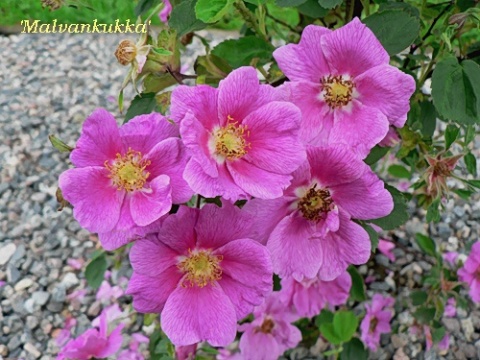
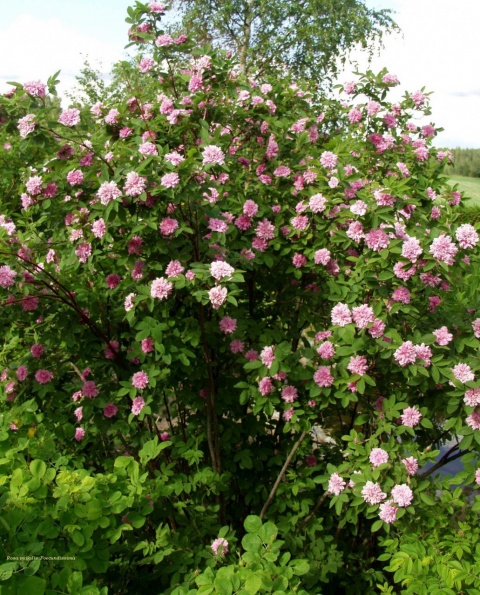
Speaking " uncovered roses " I mean all varieties that can tolerate winters 4th climatic zones (not softer) without any shelters , regardless of which systematic group according to the modern classification they belong to. Of course, representatives of the tea-hybrid, floribund, and others, whose Indian evergreen ancestors left in the inheritance not only repairability, but also the lack of frost resistance, will not fall on the list of shelter coverings. The use of the term “uncovered” is more informative than “park”, for example. Well, they don’t grow near Moscow and St. Petersburg, but without shelters, but are considered to be parks. In my subconscious mind, “park” is a kind of antipode of greenhouse, pottery, sissies carried out in the warm season to the front flower bed. A park, in contrast to a flower bed, is something peripheral, landscape, with a stable perennial combination of tree and shrub species that do not require annual transplanting or heaps of protective structures. The park should look and winter! Maybe in England, Baston and Bourbon parks are parks, but we don’t. And why are not climbing climbers mentioned in the park?
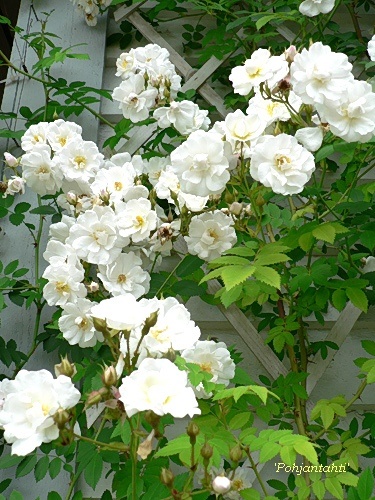
The most cold-resistant climbing rose in the world: Polstjarnan, Pohjantahti, Polaris. Described in the USA, in 1932, a hybrid of R.beggeriana × polyantha “Orleans”. However, it is believed that the European "edition" of the variety is different from the original one and is described in Finland. Every Scandinavian nation considers it its wealth. Clouds of fragrant flowers, three-meter scourge, not requiring removal from supports and shelter for the winter.


The closest to her on the stability of Emelie, mutation Cordesian varieties "Leverkusen", discovered in 1963 in the Norwegian city of Hamar, propagated, introduced into culture by the famous rose breeder Lennart Melby. The faint aroma, but abundant flowering, shiny leathery leaves and long, up to 3m whip, make Emily very decorative. And more sustainable than the original variety, the petals of which are lemon-colored.

There are very few frost-resistant climbing roses. Another mention is the variety "Geschwinds Nordlandrose" (hybrid R. multiflora) 1884, and "Geschwinds Orden" (R.rugosa × R.multiflora)1886.
Some varieties of the hybrid group Francofurtana, R.majalis × R.gallica are common in Northern Europe. Agatha - own-rooted one-time from this group, known in Sweden since 1800.
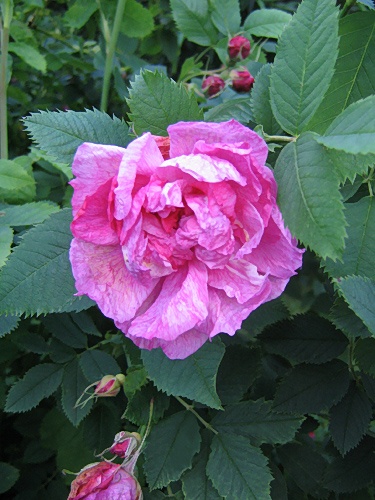
Very stable, grows in areas of the 3rd zone. Often aggressive, behaves like a weed, for decades has flourished in poor soils. It can be found in the wild on the site of Karelian villages that disappeared in 1939. It has many local names. In the mid-1980s, publications suddenly appeared that it was Redout’s “Rosier de Francfourt”. May be. During these years, there was a general tendency to seek out the German and French roots of naturalized varieties in the North.
Example: Valamonruusu from this group is known to everyone in Finland. The name, which refers to the place of origin, Balaam Island, is understood without translation. It turned out to be called "Francofurtana Splendens", a variety of Central European origin. For me, these are statements like: "Our elephant is the largest elephant in the world." Such statements, based only on the outward resemblance of plants, without serious morphological and genetic analysis, are illegal. Winter-resistant roses have been cultivated in the North for tens and hundreds of years. They are transferred from neighbor to neighbor, and not acquired in nurseries. Many roses form viable seeds, and part of the offspring will no doubt be outwardly similar to their parents. Finns distinguish several forms of Valamonruusu, all non-double-edged, with large, 8-10 cm, sometimes up to 12 (!) Cm, bright and very fragrant flowers.

I will mention two more common cold-resistant varieties of this group: Fr. Grandiflora and Fr. Alika. The latter is described and registered in the USA by Professor Hansen, who brought seedlings from ... Russia in 1906. I had to dig up young rose bushes on the side of the road. I doubt that they are the product of cuttings or vaccinations. In Finland, there is a collective name for numerous local forms and varieties of this group: kirkkonruusu - the church rose. Indeed, you can often see them in hedges on the churchyard.

R.gallica has other common resistant varieties, for example R.gallica var. officinalis and Rosa Mundi (R.gallica ‘versicolor’), its variation (1583).
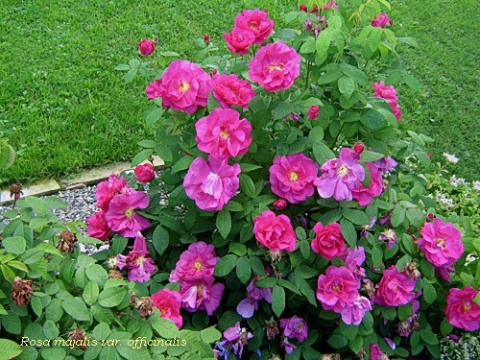
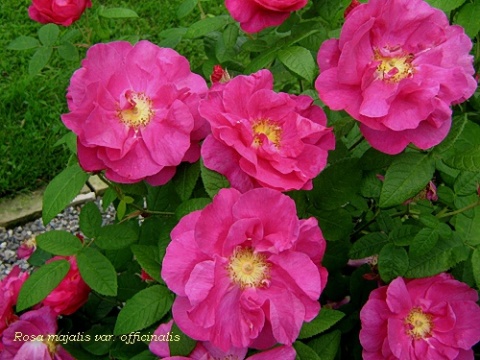
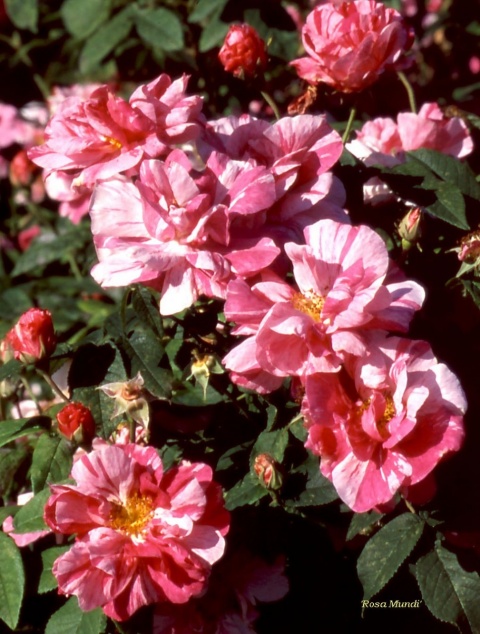
Externally similar to the R.gallica varieties are the derivatives of R.pendulina (alpina), here is one of the Finnish varieties, "Kempeleen Kaunotar".
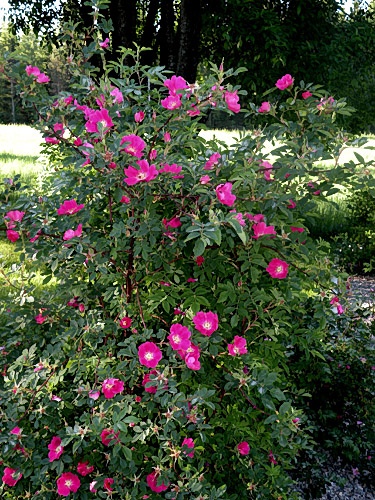
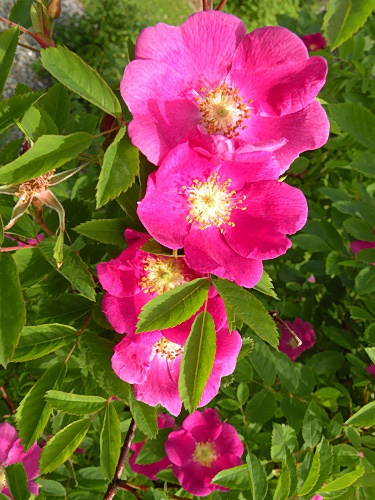
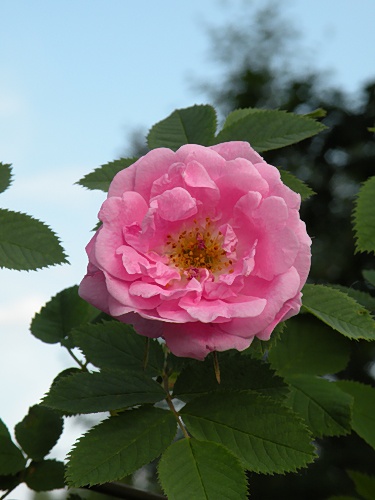
others consider it a derivative of the Alba group. But it is better to talk about this group separately. What nesting varieties are found in your area?
This post contains materials from Roseexpert (Norway), Suomen Ruususeura, The Swedish Rose Society, Českého Rosa Klub.


